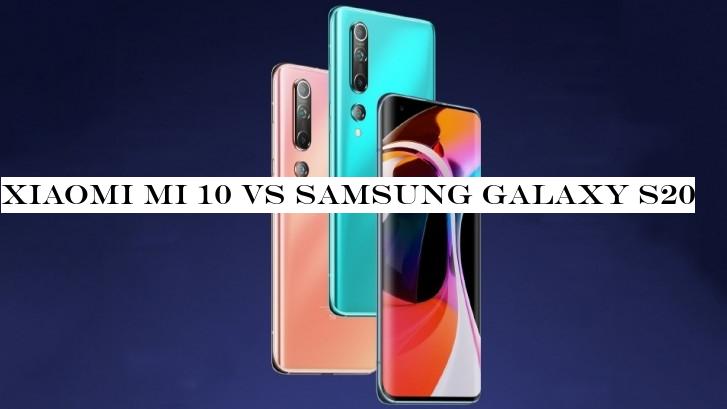INSUBCONTINENT EXCLUSIVE:
The Xiaomi Mi 10 is a more affordable flagship than the Samsung Galaxy S20, but it has many similar features
differences between these two phones across a range of categories, including display, design, camera, battery, and chipset, so you can make
AU$1,349 for a 4G version with 128GB of storage and 8GB of RAM
15, or an undetermined later date, depending on country.DesignThe Xiaomi Mi 10 (Image credit: Xiaomi)Both the Samsung Galaxy S20 and Xiaomi
Mi 10 have a metal frame and a glass back, with the most obvious difference being the cameras
left.The rear camera array meanwhile is in the top left corner in both cases, but the camera block is significantly larger on the Galaxy
S20.The Samsung Galaxy S20 (Image credit: TheIndianSubcontinent)Other differences include colors (the Samsung Galaxy S20 comes in Cosmic
Grey, Cloud Blue, Cloud Pink, Cloud White and Aura Red, while the Xiaomi Mi 10 comes in Coral Green, Twilight Grey and Peach Gold), and
dimensions and weight (151.7 x 69.1 x 7.9mm and 163g for the Galaxy S20, and 162.5 x 74.8 x 9mm and 208g for the Mi 10).So the Xiaomi Mi 10
Samsung Galaxy S20 is IP68-certified, meaning it can survive being submerged in up to 1.5 meters of water for up to 30 minutes
a big difference in size here, with the Xiaomi Mi 10 having a 6.67-inch screen while the Samsung Galaxy S20 has just a 6.2-inch one.Both use
AMOLED (Dynamic AMOLED 2X in the case of the Galaxy S20 and Super AMOLED for the Xiaomi Mi 10), and both support HDR10+, but the Samsung
That should ensure content looks smoother on the Galaxy S20, but you can only use that 120Hz refresh rate if you drop the resolution to FHD+
refresh rate or a higher resolution than the Xiaomi Mi 10, but not both at once.Camera and batteryThe camera is one area where the Xiaomi Mi
10 is actually closer to the Samsung Galaxy S20 Ultra in some ways, as just like that phone it has a 108MP main sensor.Specifically, it has
a 108MP f/1.7 sensor with optical image stabilization (OIS), joined by a 13MP f/2.4 ultra-wide one, a 2MP f/2.4 macro one, and a 2MP f/2.4
depth sensor.The setup on the Samsung Galaxy S20 is quite different, as it has a 12MP f/1.8 main sensor with OIS, a 64MP f/2.0 telephoto one
with OIS and 3x hybrid optical zoom, and a 12MP f/2.2 ultra-wide one.So you get more megapixels in total on the Xiaomi Mi 10 as well as more
camera on the Galaxy S20 (Image credit: Future)Both phones can also record video in up to 8K quality, and you get a 10MP f/2.2 snapper on
have to wait for our full Xiaomi Mi 10 review for a clearer idea of that, but the Samsung Galaxy S20 certainly has a very capable
remember the S20 also has a smaller screen to keep lit up.The Xiaomi Mi 10 should also charge faster, with 30W power for both wired and
wireless charging, while the Samsung Galaxy S20 can manage 25W wired or 15W wireless.The two phones both also support reverse wireless
charging, which lets them wirelessly juice up other devices
This can be done at up to 9W on the Galaxy S20 and 5W on the Xiaomi Mi 10.Specs and featuresThe Xiaomi Mi 10 has a top-end Snapdragon 865
chipset paired with either 8GB or 12GB of RAM
128GB or 256GB in the Xiaomi Mi 10, whereas you can only get the Samsung Galaxy S20 with 128GB, but that phone also has a microSD card slot,
You get One UI 2 on the Samsung Galaxy S20 and MIUI 11 on the Xiaomi Mi 10
These lead to different looks and pre-installed apps, but the underlying operating system is much the same.Both phones also have an
in-screen fingerprint scanner.The Xiaomi Mi 10 (Image credit: Xiaomi)TakeawayThe Samsung Galaxy S20 and Xiaomi Mi 10 have broadly similar
designs, chipsets, RAM amounts and storage, but the Xiaomi Mi 10 has a bigger (albeit lower resolution) screen, more camera lenses, and a
waiting for our full review before buying the Mi 10.Plus, the Samsung Galaxy S20 does have the edge in some areas, such as its 120Hz refresh
rate and water resistance, so the decision might come down to which features you most value
10.gBSVGQQuV5SSBFk7cNPK6A.jpg?#

